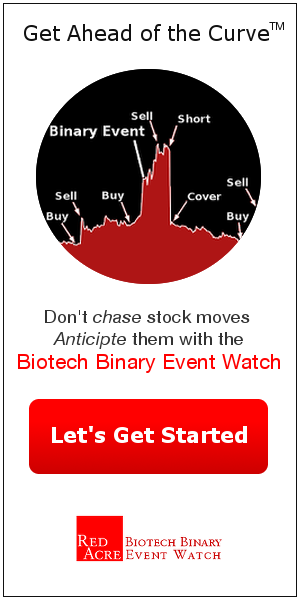Savient Pharmaceuticals (#SVNT) released third quarter earnings today and the stock is down 20% to $1.12 in pre-market trading as of this writing. The main driver for the selloff is the lackluster quarter over quarter sales growth. Quarter over quarter revenue growth came in at 13% which is well below the 30% Q over Q growth seen in the second quarter. The market was looking for Q over Q sales growth of 20% or more to confirm that the rally from Q2 was sustainable. As we wrote previously, the Q2 rally was based on the Tang lawsuit contrarian trade, and the investment thesis for SVNT is now based on revenue growth. We believe that the selloff in SVNT is likely to continue since the Q3 sales numbers may not support a path to profitability before SVNT's current cash runs out in Q2 2014. Market sentiment is likely to turn very negative for SVNT based on the lackluster sales growth. Already in pre-market, SVNT is off 20% down to $1.12 as of this writing.
Price Increases Not Fully Reflected in Revenue
During the Q3 conference call, SVNT management stated that the 12% price increase in Q2 and the 15% price increase in mid Q3 are not fully reflected in the third quarter earnings. Management suggested that, due to contractual sales agreements, price increases take up to six months to be fully reflected in top line growth. We note that, according to this six month timeline, 67% of the 12% May price increase should have been reflected in top-line numbers in Q3. This suggests that, of the 13% q over q sales growth, 8.6% should be attributable to the May price increase suggesting that 4.4% of revenue growth was due to unit increases (selling more products). Management suggested that, while price increases take 6 months to be reflected in average selling price (ASP), the upward revision in ASP takes longer than 6 months to catch up to the revised prices. CEO Louis Ferrari stated that: "the full benefit of the Q2 and Q3 price increases will not be fully reflected in revenue numbers until the first quarter of 2013".
EU Approval and Partnership Possibilities
Management stated that, after the EU's CHMP adopted a positive opinion regarding approval of KRYSTEXXA, EU partnership negotiations have progressed. The company guided that an EU partnership could be finalized by late Q4 2012 or sometime in Q1 2013 which is when the drug would be ready to be marketed in the EU.
What's Really Limiting Sales
In response to a question about sales uptake, SVNT management suggested that educating providers about refractory chronic gout (RCG) was the main limitation in increasing sales. On the other hand, when asked how many new patients initiated treatment, the company stated that "based on vials shipped we have no way of knowing how many are new patients Vs. existing patients. Some of our patients take a course of treatment, stop treatment, and then re-initiate treatment so we have no reliable algorithm for determining this." The company is using their "KPIP" (KRYSTEXXA Patient Initiation Program) to entice RCG patients to try KRYSTEXXA. The KPIP program provides the first two does of KRYSTEXXA for free. The company is finding that patients who see consistent serum uric acid decreases after the first two doses are continuing on to become customers at a high rate. Our view is that the KPIP program and SVNT's other marketing efforts are minimaly effective at best.
How Many Patients are on KRYSTEXXA - A Rough Estimate
Although the company states that they have no idea how many new patients were assigned to KRYSTEXXA, let's do some math to get a rough estimate on the number of actual patients. First, according to SVNT's investor presentation at the Rodman and Renshaw Global investment Conference (click the link and submit contact details to access the presentation), the list price for KRYSTEXXA in September was $2,951. Since the ASP is lower than the list price, and since the 15% price increase only occurred in August, let's use $2,500 as the average per-vial cost. Next, Krystexxa is given as a bi-weekly infusion, therefore, over the course of one quarter, a total of 6 doses (on average) would be given to each patient who stays on therapy. Let's assume that all patients are in the KPIP program where they get 2 free doses, so only 4 doses per patient will be counted (note this assumption effectively overestimates the number of patients if some are not in KPIP). Thus, in each quarter, each patient could potentially generate $10,000 in revenue on Q3. During Q2, the 12% sales price increase had not taken effect, so let's assume that the cost per vial in Q2 was only $2,200. using the same 4 vials per patient assumption, in Q2 each patient should have generated $8,800 in revenue.
SVNT had $4.5 million in revenue from KRYSTEXXA sales in Q3 and $3.9 million in KRYSTEXXA revenue in Q2. using the $10,000 and $8,800 revenue per patient for Q3 and Q2 respectively suggests an estimate for patient counts of 450 patients in Q3 and 443 patients in Q2. Keep in mind, these numbers are a rough estimate only. Since patients start therapy at all points throughout the quarter, the average number of vials per patient could be lower. Furthermore, the only data we were able to find regarding the average selling price for KRYSTEXXA was the fact that SVNT's agreement with the VA involves selling to VA members for a discount of 24% from the list price as reported in their Q2 2012 form 10-Q.
What is important in the above estimates is not the actual numbers, but the relative change in numbers from quarter to quarter. Even if we assume that the Q3 revenue per patient was exactly the same as it was in Q2, the number of patients for Q3 would be 511, or an increase of just 15%.
SVNT has estimated the RCG patient population to be approximately 120,000 patients as noted on today's call and in the investor presentation linked above. Given that the clinical trials found that 42% of patients were responders, let's assume that the serviceable market is 50,400. Assuming that our model is off by 100%, i.e. assuming that 1000 patients were treated in Q3, this represents only a 2% market penetration of the potential responder population.
Conclusion
For a drug with no competition for the condition of RCG, a 2% market penetration after being on the market for 18 months indicates commercial failure. Management highlights the best case scenario by cherry picking facts to focus upon, but the reality is that either they have grossly over estimated the size of the RCG market, or they are failing miserably at gaining market traction.
Our view is that SVNT will continue to have problems gaining market penetration in the future, and that concerns over cash utilization and debt maturities will continue to be a burden on the stock. An EU partnership may be viewed positively, but any gains from such an event will likely be fleeting as the cash burn continues to be an issue. The Tang lawsuit in May caused a special situation trade that resulted in gains of more than 400%; however, SVNT's current sales trajectory suggests that the stock is headed lower once again.



